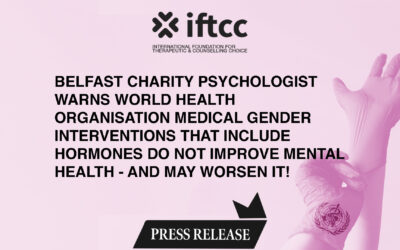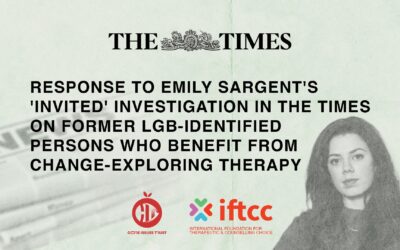Download a pdf document of this article here
On Friday 4th of February the Consultation on ‘conversion therapy’ ended. Core Issues Trust, X-Out-Loud and the International Federation for Therapeutic and Counselling Choice (IFTCC) each submitted separate and distinctive documents. Perhaps unsurprisingly, each of the submissions disagrees with the Government’s plans to introduce a ban on therapeutic choice or what they call “conversion therapy”. Each submission states that we “strongly disagree” with the Government’s intentions. We believe that answers such as “neither agree nor disagree” concedes to the government’s plans to end therapeutic choice, despite promises made to the contrary. Perhaps the substantive part of our response that we’d like to highlight, is to be found in question 3:
Talking conversion therapy
- The Government considers that delivering talking therapy with the intention of changing a person’s sexual orientation or changing them from being transgender or to being transgender either to someone who is under 18, or to someone who is 18 or over and who has not consented or lacks the capacity to do so should be considered a criminal offence. The consultation document describes proposals to introduce new criminal law that will capture this. How far do you agree or disagree with this?2.
- How far do you agree or disagree with the penalties being proposed?
- Do you think that these proposals miss anything?
Introduction. The Talking Conversion Therapy Question:
The phrasing of this question is at odds with allowing any support of change in sexuality. We will tackle the problems in the question, and then we will challenge the stance of the government in posing this question.
Our organisation does not support people under the age of 18. We offer support only to those adults who consent to it and ask for it of their own free will. We disagree with criminalising the support of anyone in identifying with their biological sex. We note that if the law deems that a person under 18 does not have the capacity to consent to talking therapy concerning their sex or sexuality, then a person under 18 does not have the capacity to consent to take transgender medication.
It is not clear if the question above is considered to pertain solely to professional counsellors and therapists. Despite the assurances about casual conversations and paragraph 25, this proposal may target parents, pastors and professionals if they were supportive of someone’s heterosexual side. We are not satisfied with this consultation’s explanation of what talking therapies should be criminalised, in what context and by which persons. The question talks of delivering a talking therapy with the intention of changing a person. This is grossly misleading since it suggests a context of coercion.
We use modalities that fall under the broad category of SAFE-T, which is an umbrella term for standard therapeutic interventions that support client self-determination. We do not support any coercive protocol or modality that claims to “cure” undesired sexual ‘orientations’. Clients must voluntarily ask for assistance – it is never coerced. Furthermore, categorical binary change in sexuality is not the goal. Rather, a diffuse picture is expected: some people have sexual fluidity and can move within their range in response to talking though their issues.
Consent is routinely ascertained at the start of counselling, but that does not stop a person afterwards changing their view of life and deciding that therapy is not what they would do now. These proposals suggests that retrospective change of mind about the capacity to consent is considered. That might mean that therapy to support the heterosexual side of a person who experiences attractions to both sexes may be legal until that person changes their mind. That is too subjective a basis: it would be a perpetual charter for vindictive action predicated on therapeutic goals. That would undermine the principle of consent.
This possibility of criminal proceedings means that an ordinary counsellor –typically working on their own, often in their own homes – would have to risk everything to give any support for the heterosexual attractions of a both-sex attracted person, even if they satisfied the criteria in paragraph 37. Therefore the proposals are written to make this therapeutic support non-existent. The law should not allow signed consent forms to be rendered void by a subsequent change of heart. The law should not criminalise the support of heterosexual attractions, or behaviour or identity in same-sex attracted or LGBT identified people.
THE GOVERNMENT POSITION
The paragraph 1 of Command Paper 535 ‘Banning Conversion Therapy Government Consultation’ describes conversion therapy as coercive and abhorrent and as something that does not work. The definition of what the government means by the term conversion therapy is not well defined. The clearest sentence is in paragraph 2: ‘An attempt to change a person from being attracted to the same-sex to being attracted to the opposite sex’ … or to/from transgender. Paragraph 5 makes a distinction between ‘talking conversion therapy’ and ‘physical acts in the name of conversion therapy’.
The proposals are written as though change in sexuality or gender identity cannot happen. The proposals are predicated on attraction, ignoring identity or behaviour. They are also written in categorical terms as though one is either same-sex attracted or opposite sex attracted and as though clients are necessarily LGBT.
In contrast, population studies including Natsal1 show that amongst non-heterosexuals, attraction to both sexes is the ‘norm’ and those with exclusive same-sex attractions are more rare. Despite decades of consistent Natsal research, the government has not made it clear to the public that being homosexual is by no means a certainty if same-sex attraction (SSA) is experienced.
Several population studies across the world show that when a Likert scale is used, the largest group after heterosexuals are the ‘mostly heterosexual’, and that change in sexuality is a consistent pattern. Britain’s third National Survey of Sexual Attitudes and Lifestyles (Natsal-3)2 showed that most persons who had same-sex sex partners had also had opposite-sex sex partners, and many reported experiencing sexual attraction to both sexes. Less than half of these persons identified as gay, lesbian or bisexual and many resolved this disparity, over time, in favour of sexual relations with persons of the opposite sex. In Natsal-3, approximately 2.9% of people were sexually active with the same sex or both – but another 2.9% had desisted same-sex sex five or more years ago. (Geary et al 2018, S2 Table)2.
To discriminate against a change in sexuality towards heterosexuality is to discriminate against any non-heterosexual who prefers their heterosexual side.
UK’s Office for National Statistics shows that almost a quarter of people identifying as bisexuals marry – almost always with the opposite sex3. Both-sex attracted people deserve support in their heterosexual relationships and goals. The state should ensure that freedom by specifically declaring such support is not ‘conversion therapy’. Helping professionals should be free to affirm the entire diversity of sexual possibilities open to the client, and not be afraid that doing so might be interpreted as ‘conversion therapy’ under penalty of law. This affects particularly bisexuals and ‘mostly-heterosexual’ people.
The Government has a responsibility to ALL its population. It is deeply concerning that the government is ignoring its own population studies to support of the narrative of homosexual and transgender activists at the expense of other minority demographics.
THE UK GOVERNMENT BELIEVES SEXUALITY IS “INNATE” – RESEARCH DISAGREES
Paragraph 52 of the consultation frames sexuality as something “innate” (ie fixed) even though the Royal College of Psychiatrists said in its Position Paper PS02/20144 that sexuality is ‘determined by a combination of biological factors and postnatal environmental factors.’ They also said ‘It is not the case that sexual orientation is immutable or might not vary to some extent in a person’s life’. In other words, sexuality is not innate. The government appears intent on promoting an ideological view of homosexuality rather than reflecting the evidence of its own research, especially its population studies as discussed below.
Robust research shows that sexuality is not innate, and it can change. The American Psychological Association’s APA Handbook of Sexuality and Psychology5 accepts same-sex sexuality is not simply biologically determined but also develops from life experiences. It says, ““Biological explanations, however, do not entirely explain sexual orientation. Psychoanalytic contingencies [largely include family experiences] are evident as main effects [stand alone factors] or in interaction with biological factors….A joint program of research by psychoanalysts and biologically oriented scientists may prove fruitful.” (v. 1, p. 583) It also accepts that same-sex attractions not only develop through life experiences, they also commonly change through life experiences. It says, “…research on sexual minorities has long documented that many recall having undergone notable shifts in their patterns of sexual attractions, behaviours, or identities”.5 Below we discuss research from overseas and in the next section we discuss British research.
The co-editor-in-chief of the APA Handbook of Sexuality and Psychology, Professor Lisa Diamond, and Clifford Rosky – a professor of law, wrote that sexual identity, attraction and behaviour are different traits which are not always concordant, and that each of these commonly changes. The international research that they reviewed in their landmark paper (Diamond and Rosky 2016)6 showed that the largest group of same sex attracted people are those described as ‘Mostly Heterosexuals’. They argued that: sexuality is not immutable / inborn; that some people do change in their sexuality; and LGB rights don’t need ‘immutable’ as a basis. They said, “We hope that our review of scientific findings and legal rulings regarding immutabilty will deal these arguments a final and fatal blow….immutability claims have been oversimplified and overgeneralized.” (p. 2) Diamond and Rosky (2016) referred to the many reported changes in the population studies as naturally occurring. They did not support the idea of ‘efforts to wilfully change’ and did not address counselling support for natural change. They argued that sexual minorities who experience their sexuality as fixed should not be privileged over those who experience their sexuality as fluid.6
In the USA’s 2012 National Longitudinal Study of Adolescent Health, over a six-year study, Savin-Williams et al (2012)7 found nearly three-quarters of those equally attracted to both sexes (ie bisexual) experienced change in sexual attraction, mostly toward or to heterosexuality. More than a fourth of exclusively same-sex attracted women changed, about half of these to exclusively heterosexual attraction. One in twelve to thirteen of exclusively homosexually attracted men, also changed, mostly to exclusively heterosexual attraction. Female ‘mostly heterosexuals’ outnumbered all other SSA categories for both sexes together. Over a third of mostly heterosexual women changed to heterosexual, only one in 56 changed to homosexual4. This study was reviewed by Diamond and Rosky (2016)6, along with studies on several other robust, international datasets which have evidence that corroborate these patterns of change in sexuality: Growing Up Today Study – ‘GUTS’ – (USA)8; National Survey of Midlife Development in the United States – aka ‘MIDUS’ or ‘NSMD’ – (USA)9; and Dunedin Multidisciplinary Health and Development Study -‘ DMHD’ – (New Zealand)10. Below we will briefly review data from the UK’s Natsal-3 dataset, which focusses on behaviour and identity and which shows that a significant proportion of people desist same-sex sex and continue with opposite-sex sex.
The lack of acknowledgement of this pattern is partly due to politics but is also due to proportion and number. Heterosexuals hugely outnumber other sexualities. So even a tiny proportion of heterosexuals moving to or towards homosexuality, can outnumber even a large proportion of sexual minorities moving to or towards heterosexuality. Policy has ignored the evidence for the latter demographic, and as a result their freedoms are at risk.
The Royal College of Psychiatrists4, Diamond and Rosky (2016)6, and a U.S. nationally representative survey of LGB people’s reported experiences (Herek et al., 2010)11 all acknowledge that some individuals – particularly those attracted to both sexes – may have a degree of choice in their sexuality. Social context has a bearing on this. At minimum, a behavorial choice is implicit when a person who is attracted to both sexes forms an exclusive committed relationship with one partner of the opposite sex. Why should such a relationship be pathologised by the criminalising of counselling to support them in their relationship to the opposite-sex person they love?
Why can’t natural change in sexuality be supported? If the proposed law does not recognise sexual fluidity, it will constrain counselling into a fixed straight/not-straight binary model. If the law cannot specifically enable the support of opposite sex relationships of both-sex attracted people, then support for faithfulness in marriage would be predicated on one’s sexuality – a clear discrimination.
WHAT ABOUT NATSAL?
Natsal1 is a well respected, robust British study which is run once a decade to provide data to inform government policy about sexual health and related issues. As such it focusses on sexual behaviour whereas many overseas studies focus on attraction or orientation identity. It is funded in part by Wellcome and part through government funded bodies. Natsal-3 involved the University College London, the London School of Hygiene and Tropical Medicine, NatCen Social Research, Public Health England, and the University of Manchester. Natsal-4 is currently underway.
Natsal-3 asked its 15,162 participants to describe themselves as either Heterosexual, Gay/Lesbian, Bisexual or Other. It also asked people to describe their attractions and experiences on a sliding scale similar to that used by Kinsey. The results show that more people admit to same sex attractions and experiences than identify as LGB, indicating lifestyle choices are often not based solely on attractions.
Geary et al (2018 S2 Table)2 reported Natsal-3 data that showed that approximately 2.9% of respondents had same-sex sex within the last five years – and that 2.9% of people had desisted same-sex sex five or more years before. The same data showed that significant proportions of those having same-sex sex were sexually active with the opposite sex too, regardless of sexual identity, especially among women. Most of those who had desisted same-sex sex continued with opposite-sex sex and identified as straight. The pattern of desisting same-sex sex is shown in the previous surveys Natsal 1 and 2.1
What Natsal-3 data shows2 –
(1) Sexual fluidity can run in both directions.
(2) Approximately 2.9% people had same-sex sex within the last five years, but another 2.9% had desisted same-sex sex five or more years ago.
(3) Both these groups had opposite-sex sex. Opposite-sex was more common in the group that had desisted same-sex sex (86.3% men, 90.7% women) but opposite-sex sex was still common (44% men 72.1% women) amongst those who were sexually active with the same sex.
This indicates that same-sex sex and LGB identity are no bar to heterosexual behaviour or lifestyles, which begs the question why the government is trying to impose such a bar by criminalising counselling that supports heterosexuality in people with an LGB history.
The Consultation plan shows no awareness of people who stop having gay sex, or the heterosexual attractions and heterosexual behaviours of same sex attracted people, despite decades of research which tells them about this. The proposed bill would bar these people from support for their heterosexual side – it would imply that people who have had same-sex sex or same-sex attraction are not entitled to be straight or to behave as heterosexuals. What right has the government to dictate that?
Natsal-3 started with a representative stratified probability sample of over 15000 people interviewed face to face, of whom the sexual minorities are a small subset – but Coventry University amassed a mere 30 volunteer survey respondents to bolster their foregone conclusions to support this proposed change to the law.
The formidable commitment to Natsal1 and its team make it all the more incredible that this government ignores it. Instead it formulates policy that will disadvantage key sexual minorities highlighted by Natsal. The proposed law will particularly disadvantage women, since they are more likely to be sexually fluid.
WHAT ABOUT THE ADULT PSYCHIATRIC MOBIDITY SURVEY (APMS)?
APMS is of particular relevance to sexuality because of the mental health issues of LGB people. (Chakraborty,et al 2011)12. The APMS 2007 was the first national population survey to ask about sexual orientation (identity and attraction) and sexual partnership, for which it used Likert scales. Like Natsal, it has a multistage stratified probability design. APMS bore out other studies regarding mostly heterosexual people being the largest non-heterosexual group. APMS 2007 data showing that sexual partnering is not always concordant with sexual identity (Hayes et al 2011)13 was later corroborated by Natsal-3. APMS 2007 and Natsal corroborate the evidence of sexual fluidity found overseas.
APMS and Natsal are two UK public projects that inform decision making, research and policy. How can the Government ban counselling and therapeutic support in the face of such evidence?
WHAT THE POPULATION STUDIES SHOW US:
The population studies in Britain and overseas show that same-sex attraction is not a mirror image of opposite-sex attraction. For the respective populations involved, opposite-sex attraction is overwhelmingly fixed and exclusive, whereas same-sex attraction is overwhelmingly fluid and non-exclusive. Persons with both-sex attraction commonly experience fluidity in sexual feelings and behaviour. This change in sexuality happens naturally, and should therefore be supported and not pathologised.
WHAT ABOUT THE UK BIOBANK AND GWAS?
The UK Biobank is a large-scale prospective epidemiological resource. Ganna A. et al. (2019)14 performed a major, international, Genome Wide Association Study (GWAS) 477,522 individuals including 408,995 individuals from UK Biobank and 68,527 individuals from 23andMe. No genetic determination was found – which means there is no one ‘gay gene’. Emily Drabant Conley, vice president of 23andMe, said: ‘The [GWAS] study did not find a gay gene’ – and that whereas ‘a handful’ of genetic contribution was found, its effect was small. (Drabant Conley, 2019)15.
This means that sexuality is not innate. For the UK government to use the word innate in the context of sexuality is to ignore this UK government backed research.14, 15 It also ignores much older twin studies. Identical twins share genes and prenatal biological environmental factors, yet if one has same sex attraction, the other usually does not. A major Australian twin study showed the chances of identical twins both being gay was at most 20-24%, whereas if sexuality was genetically determined, there would be 100% match in the sexuality of monozygotic identical twins. Bailey et al (2000).16
WHAT ABOUT THE ONS?
The ONS3 shows that roughly a quarter of bisexuals marry, almost all to the opposite sex. How is the UK going to support married bisexuals if support of heterosexuality in same-sex attracted people is perpetually at risk of criminal action (see above)? The risk to the counsellor would be prohibitive! The proposed law will stigmatise people who are attracted to both sexes, even though they are the majority of non-heterosexuals.
How can the government claim to support the protected characteristic of bisexuality if it inhibits and stigmatises counselling in support of their opposite sex marriages? How can it claim to support the protected characteristic of marriage if it restricts the marriage counselling to exclude the opposite sex relationships of bisexuals?
How can the government claim to support the protected characteristic of sexuality when it won’t acknowledge the characteristics of the largest demographic of people with same-sex attraction – ie the mostly heterosexual people?
WHAT ABOUT THE EVIDENCE THAT THERAPY TO SUPPORT CHANGE IN SEXUALITY IS NOT HARMFUL?
We disagree with paragraph Paragraph 14 and 15 of the consultation which imply that any assisted change in sexuality is harmful. Rosik (2017)17 highlights the dangers of ‘resolving matters of professional practice through legislative action’. His recommendations for the conduct of research, legislative and judicial deliberation are pertinent here.
In 2009, the American Psychological Association (APA) claimed that a lack of evidence prevented them from making conclusions about the possibility of harm from Sexual Orientation Change Efforts (SOCE) and its effectiveness.18 That lack motivated fresh research, some of which is outlined below.
This government consultation partly relies on a study by Blosnich et al (2020)19. That study claimed that SOCE increased the risk of suicidality and it recommended “minimizing exposure of sexual minorities to SOCE” – a euphemism for banning. The dataset for that study is the USA Generations study, a nationally representative study of 1,518 LGB identified people in three cohorts over a half a century who reported they experienced ‘conversion therapy’ (religious in nature in 88% of the cases). The data set was collected by at the Williams Institute at the University of California at Los Angeles, which is renowned for LGBT research and policy.
Sullins (2021)20 seriously challenged the findings of Blosnich et al (2020)19, pointing out that the latter had not used the data that showed when suicidality was experienced by the participants. In 2022, the well-respected ‘Frontiers in Psychology’ published a further peer reviewed paper by Sullins21, this time focusing on people for whom SOCE had not been successful.
In these two papers, Sullins analysed the same data set using all the data available, namely before and after therapy, not just after therapy. He found most of the suicidality existed before therapy, not after therapy20,21. Unsurprisingly, people who were suicidal went to therapy more often than people who were not suicidal, and the therapy reduced their suicidality.20
The same data set revealed that there were no differences between LGB people who experience SOCE and those who did not experience SOCE on measures of psychological distress, current mental health, substance abuse, alcohol dependence, self-harm, suicide ideation, suicide planning, suicide intentions, and suicide attempts21. Sullins showed specifically that even “sexual minority persons who had undergone ‘non-efficacious’ SOCE therapy did not suffer higher psychological or social harm. Concerns to restrict or ban SOCE [sexual orientation change efforts] due to elevated harm are unfounded”. 21
Since the study was nationally representative, the generalisation can rightfully be made that change-allowing therapy reduces suicidality even in LGB-identified people who do not change (they continue to identify as LGB). As Michael Cook of MercatorNet said: ‘If Sullins is right, depriving LGB people of the possibility of seeking therapy could lead to more suicides, not fewer.’22
The UK government should adopt the findings of Sullins20,21, that SOCE can reduce suicidality in sexual minorities.
In addition to the papers above, Sullins et al (2021)23 conducted a further study on 125 male SOCE participants unbiased by current sexual orientation, to examine efficacy and risk of SOCE and provide non-anecdotal evidence. That study found, “Net change was significantly positive for all problem domains”. Specifically, sex, sexual ideation, desire for same-sex intimacy, and kissing decreased toward the same sex and increased toward the opposite sex. Depression and suicidality significantly decreased, and self-esteem significantly increased. Forty-one percent of the men were married, nearly all with children, on average 3 children each. The participants perceived SOCE as effective and safe. Their changes likely meant a great deal for them, their wives, and their children.
Other work challenging the claims against SOCE include that by Pela and Sutton (2021)24. They published a two-year, prospective, longitudinal study which examined the sexual attraction fluidity and well-being of 75 adult male USA psychotherapy clients. These participants significantly decreased same sex attraction expressions, significantly increased opposite sex attraction expressions, and significantly changed sexual attraction identity in the heterosexual direction. Well-being significantly and clinically improved with a strong effect. The study showed that ‘exploring sexual attraction fluidity in therapy can be effective, beneficial, and not harmful.’ This paper also reviewed the literature on change in sexual attraction fluidity. The authors’ view was that since sexual attraction experiences can change naturally, then some people should be able to influence their attractions.24
The papers outlined above strongly indicate that it would be harmful to ban therapy that is voluntarily sought by those with unwanted same sex attraction.
IN CONCLUSION
Population studies show that after heterosexuality, mostly heterosexual people are the next largest group, and change in sexuality is common in this group and in bisexuals. This brings into question the rationale of inhibiting counselling support for the heterosexual objectives of people with some level of same sex attraction, whilst enabling counselling support for the homosexual objectives of people with some level of heterosexual attraction. Combined with the threat of criminal action, this raises serious issues of justice including self-determination and free speech.
Natsal1, ONS3 and APMS12,13 are rigorous, statistically robust studies meant to inform public policy – yet this proposed law ignores key findings about sexual fluidity that are corroborated by international studies. The government is ignoring its robust data in favour of flimsy findings.
Twin studies and GWAS did not find genetic determination of homosexuality. People are not ‘born gay’. If people are not ‘born gay’, it is discriminatory to criminalise counselling aimed at exploring heterosexual attractions whilst enabling counselling aimed at exploring homosexual attractions in both-sex attracted persons.
The government cites Blosnich et al (2020)19 in support of its arguments, but that paper has been shown to be seriously in error – its dataset shows the opposite to that claimed. A peer reviewed paper by Sullins (2021)21 reports evidence from the same dataset that therapy to support change in sexuality reduces suicidality, therefore access to such therapy should not be reduced.
We ask the Government to recognise the inadequacy of the Coventry Research that only reviewed research up till June 2020 and therefore omitted the significant advances in research by Sullins (2021, 2022)20,21, Sullins et al (2021)23, and Pela & Sutton (2021)24. We ask the government to use the UK national data that this consultation ignores, and to abandon the proposed law.
________________________________________
2Geary RS, Tanton C, Erens B, Clifton S, Prah P, & Wellings K, et al. (2018) Sexual identity, attraction and behaviour in Britain: The implications of using different dimensions of sexual orientation to estimate the size of sexual minority populations and inform public health interventions. (S2 Table and Table 3) PLoS ONE 13(1): e0189607. https://doi.org/10.1371/journal.pone.0189607
3Office for National Statistics ONS Statistical bulletin Sexual orientation, UK: 2017 Table 5: Legal Marital Status by Sexual Identity Source: Annual Population Survey (APS), Office for National Statistics https://www.ons.gov.uk/peoplepopulationandcommunity/culturalidentity/sexuality/datasets/sexualidentityuk Produced by Demographic Analysis Unit, Office for National Statistics
4 Royal College of Psychiatrists’ statement on sexual orientation Position Statement PS02/2014 April 2014
5 Rosario, M. & Schrimshaw, E. (2014). Chapter 18: Theories and etiologies of sexual orientation. In Tolman, D., & Diamond, L., Co-Editors-in-Chief (2014). APA Handbook of Sexuality and Psychology, Volume 1. Person Based Approaches. Pp. 555-596. Washington D.C.: American Psychological Association.https://www.apa.org/pubs/books/4311512]
6 Diamond LM and Rosky CJ, Scrutinizing Immutability: Research on Sexual Orientation and U.S. Legal Advocacy for Sexual Minorities, J. Sex Res. 2016 May-Jun;53 (4-5):363-91 DOI:10.1080/00224499.2016.1139665
7Savin-Williams, R.C., Joyner, K. & Rieger, G. Prevalence and Stability of Self-Reported Sexual Orientation Identity During Young Adulthood. Arch Sex Behav 41, 103–110 (2012). https://doi.org/10.1007/s10508-012-9913-y (Calculations taken from figure 1.)
8Ott, M. Q., Corliss, H. L., Wypij, D., Rosario, M., & Austin, S. B. (2011). Stability and change in self-reported sexual orientation identity in young people: Application of mobility metrics. Archives of Sexual Behavior, 40(3), 519–532. doi:10.1007/s10508-010-9691-3 https://link.springer.com/article/10.1007%2Fs10508-010-9691-3
9Mock, S. E., & Eibach, R. P. (2012). Stability and change in sexual orientation identity over a 10-year period in adulthood. Archives of Sexual Behavior, 41, 641–648. doi:10.1007/s10508-011-9761-1 http://midus.wisc.edu/findings/pdfs/1153.pdf
10Dickson, N., Roode, T., Cameron, C., & Paul, C. (2013). Stability and change in same-sex attraction, experience, and identity by sex and age in a New Zealand birth cohort. Archives of Sexual Behavior, 42, 753–763. doi:10.1007/s10508-012-0063-z https://link.springer.com/article/10/1007/s10508.012-0063-z
11Herek, G.M., Norton, A.T., Allen, T.J., & Sims, C.L. (2010). Demographic, psychological, and social characteristics of self-identified lesbian, gay, and bisexual adults in a US probability sample. Sexuality Research Social Policy, 7, 176–200. https://link.springer.com/content/pdf/10.1007%2Fs13178-010-0017-y.pdf
12Chakraborty, A., McManus, S., Brugha, T. S., Bebbington, P., & King, M. (2011). Mental health of the non-heterosexual population of England. The British journal of psychiatry: the journal of mental science, 198(2), 143–148. https://doi.org/10.1192/bjp.bp.110.082271 https://pubmed.ncbi.nlm.nih.gov/21282785/
13Hayes, J., Chakraborty, A. T., McManus, S., Bebbington, P., Brugha, T., Nicholson, S., & King, M. (2012). Prevalence of same-sex behavior and orientation in England: Results from a national survey. Archives of Sexual Behavior, 41, 631–639. doi:10.1007/s10508-011-9856-8
14 Ganna A, Verweij KJH, Nivard MG, Maier R, Wedow R, BuschAS, Abdellaoui A, Guo S, Sathirapongsasuti JF, 23andMe Research Team, Lichtenstein P, Lundström S, Långström N, Auton A, Harris KM, Beecham GW, Martin ER, Sanders AR, Perry JRB, Neale BM, & Zietsch BP 2019 Large-scale GWAS reveals insights into the genetic architecture of same-sex sexual behavior American Association for the Advancement of Science Science 365, eaat7693 (2019) doi: 10.1126/science.aat7693
15 Same-sex sexual behavior and genes: like love, the answer is complicated Emily Drabant Conley, Stat, 9 September 2019 https://www.statnews.com/2019/09/09/same-sex-sexual-behavior-genes/ See also Emily Drabant Conley of 23andMe https://www.23andme.com
16 Bailey, J M , Dunne, MP, & Martin, NG. (2000) Genetic and Environmental Influences on Sexual Orientation and Its Correlates in an Australian Twin Sample [Personality Processes and Individual Differences] Journal of Personality and Social Psychology APA Volume 78(3) March 2000 p 524–536
17Rosik CH., 2017 Sexual Orientation Change Efforts, Professional Psychology, and the Law: A Brief History and Analysis of a Therapeutic Prohibition, 32 BYU J. Pub. L. 47 (2017). https://digitalcommons.law.byu.edu/jpl/vol32/iss1/3
18Beckstead L, Psyd J, Drescher J, Greene B, Miller R, & Worthington R. (2009). APA Task Force Report on Appropriate Therapeutic Responses to Sexual Orientation. 10.13140/RG.2.1.3075.8004.
19Blosnich JR, Henderson ER, Coulter RWS, Goldbach JT, Meyer IH, 2020 “Sexual Orientation Change Efforts, Adverse Childhood Experiences, and Suicide Ideation and Attempt Among Sexual Minority Adults, United States, 2016–2018” AJPH Surveillance July 2020, Vol 110, No. 7 https://doi.org/10.2105/AJPH.2020.305637
20Sullins, Donald, Sexual Orientation Change Efforts (Soce) *Reduce* Suicide: Correcting A False Research Narrative (March 16, 2021). Available at SSRN: https://ssrn.com/abstract=3729353 or http://dx.doi.org/10.2139/ssrn.3729353
21 Sullins DP 2022 Absence of Behavioral Harm Following Non-efficacious Sexual Orientation Change Efforts: A Retrospective Study of United States Sexual Minority Adults, 2016–2018 Frontiers in Psychology Vol 13 https://doi.org/10.3389/fpsyg.2022.823647 https://www.frontiersin.org/article/10.3389/fpsyg.2022.823647
22 Michael Cook editor MercatorNet ed Feb 4, 2022 Where is the evidence that ‘conversion therapy’ is harmful? https://mercatornet.com/where-is-the-evidence-that-conversion-therapy-is-harmful/77401/ Available Online Last accessed 4 Feb 22
23 Sullins DP, Rosik CH & Santero PL 2021 Efficacy and risk of sexual orientation change efforts: a retrospective analysis of 125 exposed men F1000Research, volume 10:222 DOI:10.12688/f1000research.51209.2
24Pela, C. & Sutton, P. (2021). Sexual attraction fluidity and well-being in men: A therapeutic outcome study. Journal of Human Sexuality, 12, 61-86. https://df6a7995-c8cd-4a49-bc0d-2ef92e2cf904.filesusr.com/ugd/ec16e9_08ac87b9a4a94711b6b72429723cda6a.pdf





